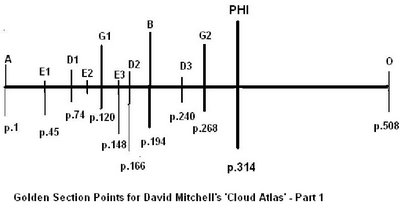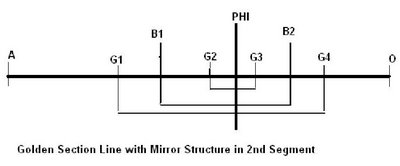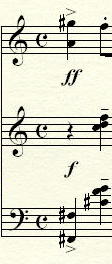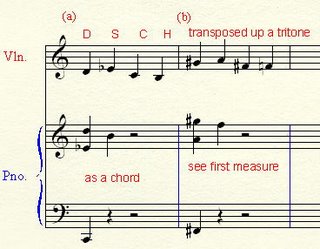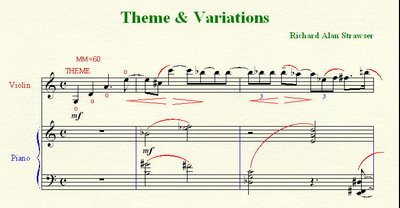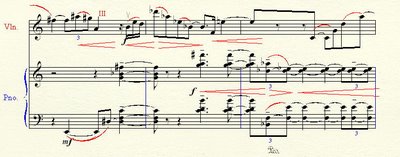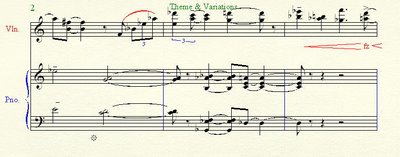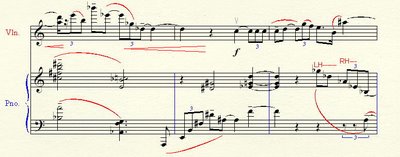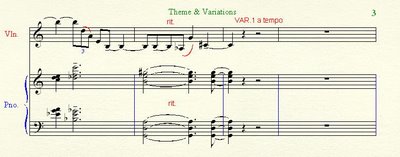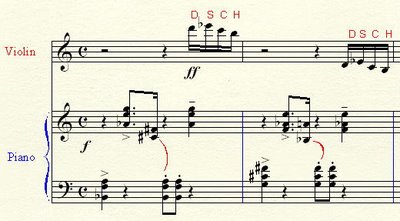
Though not reading every day – or not much at a time, at that – I slowly worked my way through David Mitchell’s “Cloud Atlas.” I would like to read more or spend more time reading, yet my “to read” pile isn’t getting any smaller as I try to get caught up on the one’s I’ve already bought. How many times have I seen something that I just had to buy now and then realize it’s out in paperback before I’d even cracked the cover? It’ll probably be made into a film by the time I’d actually get around to it, the way things are going. Time, I’m telling myself, needs to be spent composing – I’ve got the back burner warming up faster than I can manage the front one – and sometimes the only thing reading does is stoke that burner even more.
One book still on the pile is the paperback edition of Jared Diamond’s “Guns, Germs, and Steel (The Fates of Human Societies)” (what would Lynn Truss say about that second comma in “Eats, Shoots & Leaves,” another book further down on the pile). Diamond's book had already been made into a PBS Documentary which I missed (no TV set and I work evenings so who can watch TV even if it is worth watching?) but I read that Diamond’s recounting the fall of the Moriori society, a gentle tribe conquered by the war-like Maori of New Zealand, inspired an episode in the first of the six stories making up Mitchell’s novel, “Cloud Atlas.”
At first, this just seemed to be the setting for a sea-faring adventure story (or part of one) and not much else. The second story was about a young composer working for (and stealing from) an old composer (much like the story of Frederic Delius – there’s a wonderful scene between the fictional old composer and the old factual Edward Elgar, chatting by the fireplace). The third was a mystery of anti-nuclear activism in the 1970s. The fourth, a comedy, pitted a publisher against a client’s rowdy relatives (though his own proved a more serious concern). The fifth took a while for me to get into, set in some future society, a science-fiction interview with a clone created to be a fast-food server (turns out, this one was inspired by “Fast Food Nation”).
The stories are told without much immediate background: you figure out where you are or what has happened almost in passing. If you are familiar with some names and languages, it doesn’t take long to figure out Sonmi-451 is a clone in Korea or what had once been Korea – it is now a corpocracy run by a dictator with a society dominated by the cloning of “fabricants” whose purpose is to serve the people (“purebloods”). Describing modern-day workers in a typical fast food restaurant as personality-devoid clones is clever, but it becomes scarier as you realize some of these clones actually begin to achieve elements of human awareness and development (no comment, thank you) and this, the people find frightening: the clone-type Sonmi was designed to clean tables and assist at the register, but the one known as Sonmi #451 is abducted by one political or social faction for use in scientific research, then presumably is captured by police from the opposite faction and about to be executed for her “ascendancy” into knowledge considered far too dangerous for a mere fabricant. A reference to hunting on the island of Hokkaido in Eastern Korea (if you know that Hokkaido is the northern island of Japan) or a passing reference to a scientist who specializes in dealing with the American boat-people problem gives you a sense of what has happened to the world’s balance, especially chilling given the current situation with North Korea’s recent nuclear test (the novel was published in 2004) and the less recent scandal about the South Korean university scientist who had claimed to have cloned human embryos in early 2004. It is now a land where society is even more divided by class and privilege than we care not to think about now, and where clones designed for specific tasks (and treated as sub-human slaves) are given names like models of cars but where the generic word for car is ford, where people view their world and communicate through an internet-like device called a sony, where they wear nikes rather than shoes, and where movies are called disneys. It is an act of sedition to read old books or view old movies, and it is while watching a classic 21st Century film – very old – about a British publisher (from a deadland far away and long ago) imprisoned against his will in a nursing home that Sonmi-451's story reaches its climax. Just as the old movie gets stuck where the protagonist is eating peas and realizing his predicament, the police burst in to arrest Sonmi-451. The previous story, by the way, ended abruptly as the British publisher, discovering he has been imprisoned in a nursing home from which there is no escape, realized his predicament in the midst of eating peas: very clever, turning this comic moment into a double cliff-hanger.
I thought, throughout the fifth story, how clever everything was, but cleverness is not art. It may be good story telling (and in this case, it was) but I’m not sure this really IS more than a collection of stories.
In a previous post, I blogged about the book’s structure, how the Golden Section of the book occurs where the sixth story ends and the other five stories resume but continue in reverse order. The sixth story is the only one not divided into two parts, with or without a cliff hanger. It was in the midst of this one I began realizing the continuing thread between the stories: not the seemingly incidental strands of a character here, a birthmark there or a work of art passing from one generation to another but the theme that is also behind Diamond’s book – the ways in which civilized societies create their own downfall.
Set in post-apocalyptic Hawaii generations after “the Fall,” this is the story told in a future dialect by Zachary, a valleyman on the Big Island of Hawaii, of the differences and difficulties of their civilization living with the ignorant savages of the north and the brutal barbarians, known as the Kona, of the eastern side of the island. Zachary’s people look down on the Hawi because they believe in a god for everything, unlike his own people who believe in one god named Sonmi (she has gone from being a fast-food clone to a goddess, though the valleymen are completely unaware of her early history). As he approaches manhood, Zachary receives a dream from Sonmi which the local leader interprets as three things he would be tempted to do but must not do.
Into Zachary’s village comes one of the Prescients, a mysterious dark-skinned tribe from a distant northern island who seem to have maintained the magic and wisdom of the world from before the Fall. This woman is there to study their life but Zachary is convinced she’s a spy sent to learn their secrets so the Prescients can conquer them, so he is determined to destroy her. Near the end of her stay, after he’s changed his mind about the Prescient outlander, he is tempted by the realization he could still easily destroy her, whether it’s his old customs and faith speaking to him or the devil (who’s known here as Old Georgie). At the point he decides to go against this temptation, remembering the first of the things from Sonmi’s Dream, the story takes a strong turn: it is not the “climax” of the crucial resolving event but it is the defining event that determines the nature of the ensuing climax.
That was when I decided to figure out where the Golden Section of this chapter would be: a little bit of math and guess what? It’s on the very same page as the story’s “defining moment.” The half-way point (which some might think could be significant) is only eight pages earlier, but that’s in the middle of a stretch of narrative that is not terribly decisive as far as the dramatic development is concerned. It’s that conscious decision of the narrator’s not to destroy the Prescient that changes the story, and that is structurally significant – and it occurs at the story’s Golden Section. Coincidence? Hmmm...
Now, the fact the end of this “last” story occurs at the novel’s Golden Section is more, I discover, than just the point where the stories resume in reverse order. Somewhere I’d read a critic who complained the ending of the novel lacked the kind of neat revelation tying all of these stories together, but I realize now he missed the boat, quite literally – that moment is not at the end of the novel – well, in the last pages of the book you’re reading: it’s at the end of the sixth story, at which point the previous stories, each having been dramatically interrupted only to resume in reverse order, turn back to the first story set on a Pacific Ocean journey of the 1850s, picking up where the ship’s crew is dealing with a “savage” from the islands of the Moriori who has stowed away hoping to reach America. The first story was told by Adam Ewing; this last one, by Zachary – we’ve gone from A to Z – and back again.
Zachary’s story, told as an old man spinning his tale to a young audience, describes his discovery that the Prescient woman had an egg-like device that, when warmed by the hands, revealed the image of a beautiful young woman talking in a language he could not understand that also allowed people to converse through sound and images across great distances. The beautiful young woman, he is told, is the historical Sonmi, giving her pre-execution interview recorded in Story #5. After some discussion about the rise and fall of civilizations (here, btw, is the main theme), the Prescient reveals she has just discovered a plague has wiped out all of her people except the five who have been studying the islands of Hawaii: in order to save her, Zachary must help her escape to reach the others, now gathered on Maui (why Maui? remember the Moriori and the Maori) just as the Kona barbarians have embarked on their war to conquer and enslave all the people on the Big Island, killing or carrying off all of Zachary’s people.
Once Zachary has concluded his tale, having survived the Kona’s attacks and escaped with the Prescient to Maui, a short postlude is offered by his son. Does he believe his father’s yarns about escaping the Big Island? Well, he explains, “most yarnin’s got a bit o’ true, some yarnin’s got some true, an’ a few yarnin’s got a lot o’ true.” He gathers much of it about the Prescient was true, because after he died, the son found the egg-like device where the “beautsome ghost-girl appears in the air an’ speaks in an Old-Un tongue what no un alive und’stands nor never will, nay. It ain’t Smart [ancient technology] you can use ‘cos it don’t kill Kona pirates” [in one generation they have evolved from being land to sea-faring marauders attacking the other islands] “nor fill empty guts,” but he tells how in the evenings sometimes, they’ll wake up the ghost-girl ”jus’ to watch her hoverin’n’shimm’rin’” because she’s beautiful and it amazes the little ones.
“Sit down a beat or two,” he says.
“Hold out your hands.
“Look.”
And then you turn the page to begin reading the rest of the first five stories in reverse order, taking you back to the old ship’s tale about the stowaway from the Moriori tribe escaping his ruined homeland.
It would be standard operating procedure to tell the future of human civilization in a series of interlocking stories that move in a logical, chronological progression. It is “clever” to tell them in such a way the end of the story actually happens in the middle of the book, as it were, and then have them unfold in a reverse order taking you back to the beginning of the story where it concludes. It is art to come up with an ending like that which so neatly wraps up the novel’s themes and sets you up to react entirely differently, now, to each preceding story’s conclusion, reading in the light of already knowing the outcome. These stories are like Sonmi’s egg – whether you understand them or not is not the point, but I will sit down and spend part of today resuming that journey.
